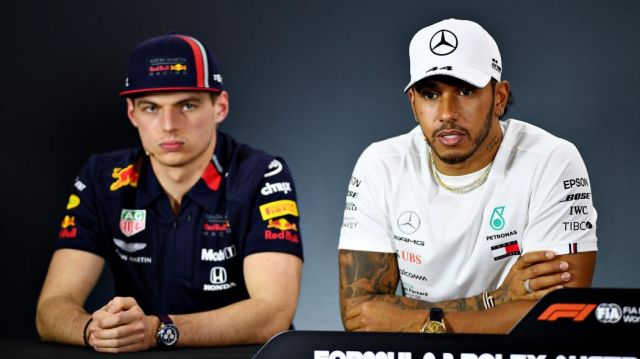
With the 2020 season making a very late start, due to COVID-19, it seems apposite to finally release this belated 2019 analysis. If the sport can pick up and continue under such difficult conditions, this blog surely can too. To those who requested this much earlier, I am sorry for the delay. Life got in the way.
While it may seem like distant history now, Lewis Hamilton sealed a sixth drivers’ title with relative ease in 2019, as Mercedes ascended once again to a position of clear dominance in the hybrid era. Beneath this thin stratosphere, there were clearly outstanding performances from other drivers, including Max Verstappen, who overhauled both Ferrai drivers in the championship standings, as well as several others who starred in the midfield. Who was the overall best performing driver?
Ranking drivers between teams is always a challenging endeavor. As in previous seasons, I used the f1metrics model to generate objective driver rankings for 2019. I note that the model was recently significantly updated to generate more robust rankings, and was used to generate the f1metrics top 100. This is the first outing for the new model in generating contemporary season rankings.
Reviewing preseason predictions
At the conclusion of 2019 preseason testing, Ferrari were universally viewed by press and analysts alike as a slightly stronger prospect than Mercedes going into 2019. This turned out to be a (Ferrari-)red herring. So what happened? Did Ferrari showboat in testing or did Mercedes sandbag? This can be answered by comparing the performances of all teams between testing and the early 2019 season.
In the graph below, the bars represent my predictions from the 2019 pre-season analysis. The blue dots represent the lap time data from qualifying, averaged across the first four races of the season.

Ferrari’s gap to most of the midfield actually slightly expanded between testing and the first four races of the 2019 season, indicating that it clearly wasn’t a case of Ferrari underdelivering in season or performing unrepresentative runs in testing. Mercedes were the exception, making massive gains relative to all other teams (~0.6% of lap time) from runs in testing to the first few races. Clearly, their testing pace was not representative. Part of this could be attributed to them not bringing their final concept to the track until the second test. Part of it could be attributed to sandbagging. Either way, no other team stood a chance against Mercedes once the races got underway in 2019.
In addition, I had used the model to make predictions about which teammate would perform better for each team in 2019. Specifically, I calculated the percentage likelihood that the driver would have higher points per counting race (excluding mechanical DNFs) than their teammate across the season. The table below summarizes where the model prediction matched the result and where it didn’t.

The two cases where the prediction did not match the result were at Ferrari, where Leclerc pactually scored more total points, but did not quite outscore Vettel on points per counting race, and at Williams, where Russell outperformed Kubica. Overall, the model’s predictions of teammate results were therefore 80% correct.
2019 driver rankings
Moving on to the driver rankings for 2019, we can see how the model rated each driver’s performance. These ratings take into account the model’s estimate of each team’s performance level, and they exclude non-driver DNFs (e.g., mechanical failures). The model uses all data from 1950-2019 to make its assessments, meaning it has informed estimate of each driver’s typical performance level — taking both age and experience into account — with the exception of rookies.
BOTTOM OF THE PACK
Four drivers clearly trailed the rest in their 2019 driver ratings.
20. Antonio Giovinazzi (4.68 ppr)


It was a torrid first full season for Antonio Giovinazzi, dominated by teammate Kimi Raikkonen 3-17 in races and 14-43 in points. Given that Raikkonen had turned 40 with age-related decline, the model sees this as the weakest driver performance of the 2019 season. In the model’s estimation, the Alfa Romeo was among the best cars of the midfield and certainly capable of more than the four points finishes that Giovinazzi delivered. In qualifying, Giovinazzi was in close touch with Raikkonen, but races saw him sliding backwards or making unforced errors. Due to his Ferrari connections, Giovinazzi has continued for a second season at the team in 2020. Much better results are needed, however, if he is attempting to follow in the footsteps of Charles Leclerc.
19. Robert Kubica (6.24 ppr)



This was not the comeback many fans had hoped for, but it was the performance many of us expected, and in line with my prior model predictions back in 2018. Considering the incredible odds that Kubica had to face — lack of recent experience, massive long-term effects of injury, a crumbling Williams team — his performance has to be viewed in context. It was a heroic achievement to even be competing in the same weight division as the world’s best drivers. Blitzed by teammate George Russell 0-18 in qualifying and 3-16 in counting races, Kubica was never likely to find a seat for 2020, but he could retire proudly. His career will remain forever a what-if — one that I have explored previously with the model. Notably, he scored the only point for the Williams team in 2019, keeping his head in the chaotic wet race at Hockenheim.
18. Kimi Raikkonen (6.29 ppr)



After several unspirited seasons at Ferrari, Kimi Raikkonen appeared to bounce back to form in 2019 at a new team, or so the prevailing narrative went. Was it a suddenly reformed Raikkonen, or was it a relatively stronger car and weaker teammate than most acknowledged? In the model’s estimation, the latter was the more probable interpretation than the former. At 40 years of age, the model viewed Raikkonen as being well into age-related decline. Moreover, Giovinazzi was close to an unknown quantity, having started only two grands prix prior to 2019. What this means is that Giovinazzi’s performances provide near-to-zero information about Raikkonen’s performance. The model’s ranking for Raikkonen for 2019 is therefore essentially where he would be expected to perform based on age, experience, and the totality of his career to date.
17. Romain Grosjean (6.39 ppr)
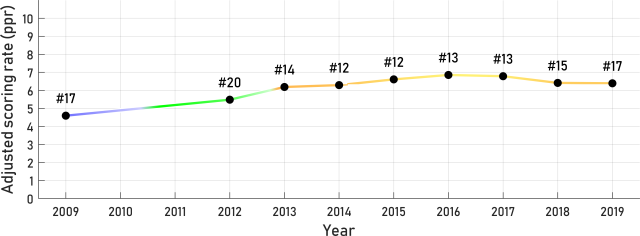


For Romain Grosjean, the 2019 season was yet another one to forget. In an often hopelessly uncompetitive Haas, he was outmatched by teammate Kevin Magnussen on all meaningful performance metrics. To top off a miserable season, the Haas challenger was a big step backwards from 2018, being only clearly able to beat Williams. The team continue to have faith in his abilities, and one can hope that Haas soon regain their competitiveness.
THE TIGHT MIDFIELD
The model rankings from 16th to 8th were a fierce battleground in 2019, spanned by only 0.58 ppr.
16. Alex Albon (6.71 ppr)
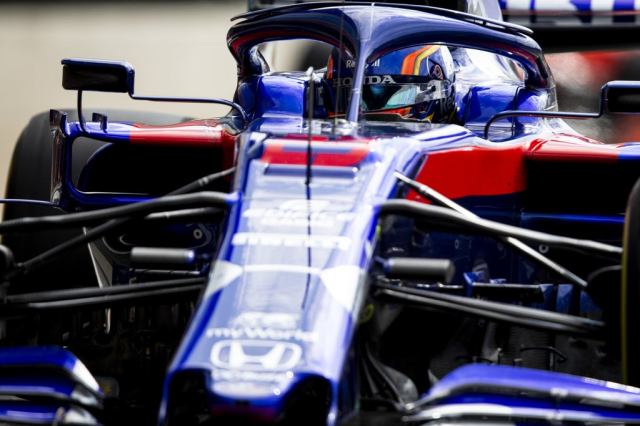

Alex Albon had a promising rookie season, which he parlayed into a Red Bull seat for 2020. Although ranked 16th by the model, Albon was part of a tightly bunched group, with just 0.29 ppr separating him from 10th place in the list. Such are the small margins that, had he not been punted off by Lewis Hamilton in Brazil, his season ranking would be 12th, placing him just ahead of both Pierre Gasly and Daniil Kvyat.
In the first half of the season, Albon was closely matched with his more experienced teammate, Daniil Kvyat. For the Red Bull team, Kvyat now serves as a reliable yardstick by which other junior prospects can be assessed. When Gasly dramatically failed to deliver at Red Bull, the team saw an opportunity to test Albon against the absolute best, and a rare opportunity to perform multiple pair-wise driver assessments – rich information for what is at its heart an extensive driver development program.
Although Albon trailed Kvyat in points, truthfully he was a close match for his more experienced teammate. The points battle was essentially lost in Germany, where Albon, in his first ever wet F1 race, had been the clearly quicker Toro Rosso driver until a late missed strategic opportunity. Without safety cars repeatedly closing the gap between them, Albon would have led Kvyat by more than a free pit-stop going into the final phase of the race.
At Red Bull, Albon was credited with delivering feistier performances than Gasly had achieved. In traffic, he was certainly more decisive, although occasionally overzealous, as occurred in Italy and Japan. On pure pace, however, the deficit to Verstappen was significant. In races where neither driver was obstructed by technical or other issues, Verstappen’s advantage typically stood around half a second, much as it had against Gasly in clean air. Whether Albon can close that gap as he gains age and experience will ultimately determine whether he is fated to be a championship challenger or a compliant number-two driver in a team currently built around Verstappen.
15. George Russell (6.75 ppr)


The reigning F2 champion spent most of his debut F1 season only battling his teammate, due to the drastic uncompetitiveness of the Williams car. While he was outscored by teammate Robert Kubica 0-1, George Russell very clearly had the measure of his teammate. The f1metrics model rates Russell ahead of Kubica, in part due to its robust scoring system that reduces sensitivity to freak results, and in part due to it awarding points beyond 10th place, allowing it to discriminate perfomances at the lower end of the grid.
As a rookie driver, Russell’s first season ranking is based on his performance relative to his teammate Kubica. The model considers Kubica’s lack of recent experience, but does not explicitly consider any lasting effects of his injury on performance. Both Russell’s and Kubica’s performances are therefore, to some degree, uncertain. No further certainty regarding Russell’s rating will be obtained in 2020, as he is racing alongside the rookie Nicholas Latifi.
14. Lance Stroll (6.85 ppr)



Lance Stroll is gradually escaping his label as a pure pay-driver. Ultimately, he could not keep pace with teammate Sergio Perez in 2019. Yet, it was a solid performance. If we look back to his rookie season, where he trailed Felipe Massa by an astounding 0.96% in qualifying, the margin of 0.29% to Perez is a major step forward. Still 21 years old, Stroll has some potential to improve, and the unusual luxury of effectively owning a seat to ensure he has the necessary time and support.
13. Pierre Gasly (6.85 ppr)
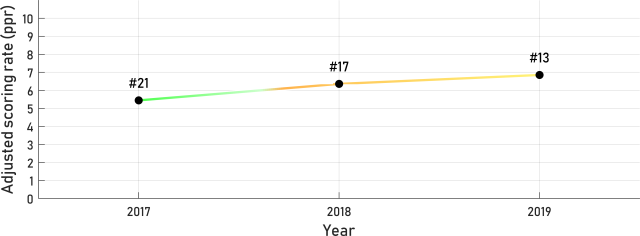
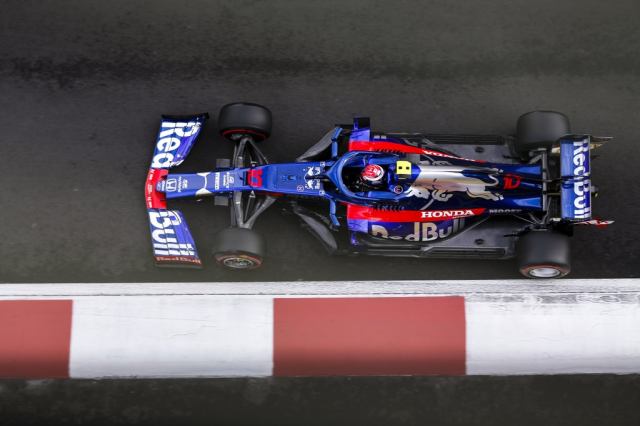

Pierre Gasly’s 2019 season was one of two utterly disparate halves. At Red Bull, he was completely steamrolled by teammate Max Verstappen, often struggling to even get within half a second. At Toro Rosso, he was a feisty performer, who comfortably outperformed teammate Daniil Kvyat, bringing back memories of his rookie performances for the team. If we feed the model only his Toro Rosso results, the model rates Gasly the season’s 4th best performer! Alternatively, if we use only his Red Bull results, the model rates him 19th.
What went so drastically wrong for Gasly at Red Bull? Besides simply lacking pace, he seemingly had no confidence in executing overtakes on clearly slower cars, meaning he spent large portions of races stuck in traffic. As a result, a 0.47% lap-time deficit to Verstappen in qualifiying ballooned to over 1% in races. His immediate return to form at Toro Rosso suggests more than a mismatch of driver style with car characteristics, and instead a psychological component. For whatever reasons, Gasly appears more comfortable and better supported in the junior team.
12. Daniil Kvyat (6.87 ppr)



Surrounded by the turbulence of Gasly and Albon fighting for Red Bull seats, Kvyat continued plugging away at Toro Rosso. Was he the best performer of the trio in 2019, as the model suggests (albeit by a very fine margin of 0.16 ppr)? The ranking order can be partly attributed to his good fortune in Germany, where clever opportunism delivered a podium from what was really an underperformance relative to Albon. In truth, there was very little to separate Kvyat and Albon during their period together at Toro Rosso. In contrast Kvyat was clearly beaten by Gasly at Toro Rosso. Yet Gasly’s performance for Red Bull were dire, and one suspects Kvyat could have delivered more in the same car. Altogether, this makes for a confusing season-wide comparison of the three drivers. What can be said for certain is that, for better or worse, there isn’t currently a worthy challenger to Verstappen within the Red Bull program.
11. Valtteri Bottas (7.00 ppr)



Bottas had a boisterous beginning to the 2019 season, looking briefly like a true challenger to his legendary teammate Lewis Hamilton. Once Hamilton found his feet, Bottas was left spinning his wheels, once again. Bottas showed glimpses of potential later in the season, but it was never enough. Ultimately he does not appear to have the ability to consistently beat Lewis Hamilton across a full season. To be fair to Bottas, it’s difficult to identify a driver in the sport who currently does. Against most teammates, Bottas would appear a much more difficult driver to beat.
10. Lando Norris (7.00 ppr)
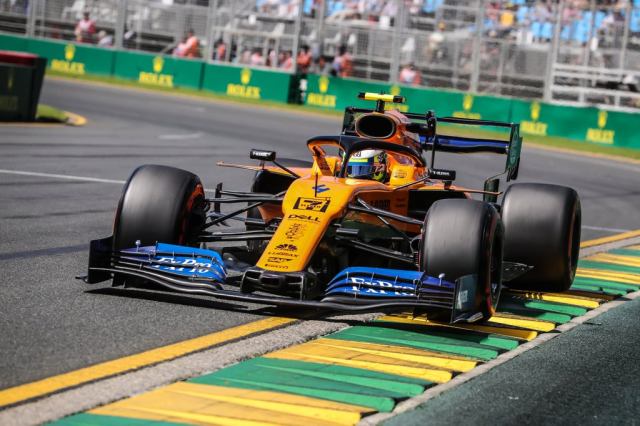

Although the official honour went to Alex Albon, Lando Norris was the model’s rookie performer of the year in 2019, just 0.25 ppr ahead of George Russell and 0.29 ppr ahead of Alex Albon. Plagued by bad luck, he made little impact in the points standings, but careful observers could see his impressive pace. Facing Sainz is a serious test for any rookie, even one of Norris’ racing pedigree. Norris was never embarassed, showing that for single-lap pace he had Sainz’s measure. With further age and experience, Norris has clear potential to trouble those at the top of the sport.
9. Kevin Magnussen (7.14 ppr)



As the model predicted before the season began, Kevin Magnussen got the upperhand over Romain Grosjean in 2019. This brought their overall tally, across three seasons together, marginally in favor of Magnussen to 29-29 in qualifying, 26-22 in races, and 95-73 in points. Yet, their characteristics as drivers are very different. Magnussen has a wider operating range, being willing to drag difficult cars along, and fight viciously for position. Grosjean is incredibly quick on his best days, but a fragile competitor, prone to inexplicable mistakes and poor adaptability. Over time, Magnussen is seemingly proving the surer bet for Haas.
8. Nico Hulkenberg (7.29 ppr)



In 2020, Nico Hulkenberg left F1, relinquishing his seat to young hotshot Esteban Ocon. Despite the unexpected call-up to substitute for the sick Sergio Perez, his days of having a full-time F1 seat appear to probably be over.
At this stage in their respective careers it can be argued who is more deserving of a seat out of Hulkenberg and Ocon. Hulkenberg has been clearly evaluated versus a range of drivers, establishing himself as a very strong driver, but never one who could quite break through to the top tier. Ocon is a less certain prospect, but with a higher potential ceiling based on his results against their common teammate, Sergio Perez. Daniel Ricciardo is a strong benchmark for us to learn Ocon’s real potential.
In any case, Hulkenberg is clearly talented enough to deserve a place on the F1 grid. He will be a highly valuable driver in other series (where his podium curse seemingly does not apply), as he remains at his peak and one of the best F1 drivers on the planet.
THE TOP SEVEN
Seven drivers stood out in the 2019 season as the model’s clear top performers, with one clearly leading the rest.
7. Daniel Ricciardo (7.75 ppr)



Daniel Ricciardo’s first season with Renault was a clear competitive setback relative to where he stood at Red Bull. As his old team switched to Honda power and won three races, the Renault works team failed to ever seriously trouble the podium. Importantly, however, Ricciardo did stamp his superiority on teammate Nico Hulkenberg, though not as comfortably as some might have expected. Ultimately, Ricciardo had a clear edge, but perhaps not the unambiguous advantage we would expect from Hamilton or Verstappen in the same seat. We can view this match-up as further indirect support of Ricciardo’s place in the overall driver hierarchy — near the best of the best, but not established there yet.
6. Sergio Perez (7.77 ppr)



In 2019, Sergio Perez was yet again a stalwart for the Racing Point (formerly Force India) team. He scored 71% of the team’s points and it was close to a clean sweep in qualifying (albeit with a relatively modest lap-time advantage of 0.29%), giving a solid beating to less experienced teammate Lance Stroll. This on the background of Stroll’s father heavily financing the race team, meaning there could be no doubts about fair treatment for the young Canadian. Perez beat him fair and square, solidifying his reputation within the team. It was not a particularly competitive season for Racing Point, but Perez helped to ensure that they comfortably beat Alfa Romeo, and even put a stern challenge to Toro Rosso and Renault.
5. Charles Leclerc (7.98 ppr)



For a driver in only his second season, Charles Leclerc displayed incredibly impressive pace in 2019, taking seven poles, more than Lewis Hamilton or Sebastian Vettel. There are still evidently some rough edges to the young Monegasque. His sublime performances were counterbalanced by rookie errors, not helped by a Ferrari that was often difficult to tame.
Ultimately, there was very little to separate Vettel and Leclerc. Through Leclerc’s bravery and sheer pace, it was clear that the Ferrari team gradually gravitated away from Vettel, the decorated former champion who no longer seemed to justify his expensive contract, and towards their young hotshot. Leclerc has tremendous future potential, particularly if he can refine his skills in the way that Verstappen has achieved so effectively in the past few seasons.
4. Sebastian Vettel (8.13 ppr)

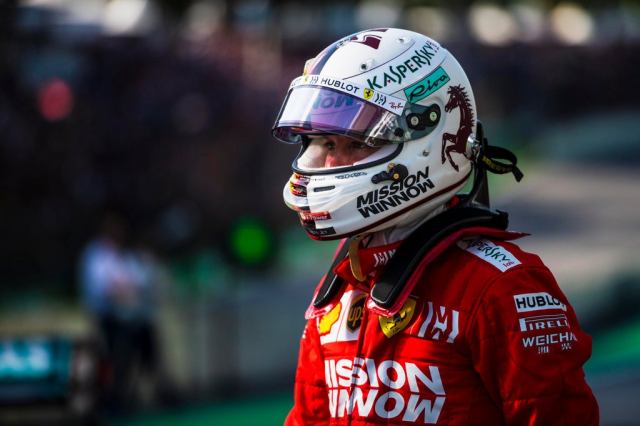

Whilst Sebastian Vettel did slightly outperform his teammate in points per counting race, 2019 could hardly be considered a successful season for a four-time champion with vastly more experience than his teammate. The Ferrari SF90, which looked so promising in testing, was seemingly a difficult car to handle. Blessed with enormous power and straightline speed (the basis of which we now know was illegal), the car was difficult to master, especially on corner exits where it was often skittish. With the added pressure of an intra-team skirmish, which threatened to boil over into war at any moment, both Ferrari drivers made several rookie-like errors across the season, interspersed with periods of brilliance. It was not a perfect season for either of them.

Driver line ups ranked based on the average ppr rating of the team’s drivers. A weighted average (weighted by number of race starts) across the three drivers is used in the case of Toro Rosso and Red Bull.
By the model’s rating, Ferrari had the strongest overall driver line up in 2019, lacking a clear number two as Mercedes and Red Bull had. Pairing two alphas in the same line-up is always a competitively risky gambit. When two drivers of similar skill are fighting for the top prizes, and neither is willing to adopt a number-two driver mentality, discontent is almost inevitable. History is rife with such examples, from Fittipaldi’s decision to split with Lotus after 1973, the drama between Jones and Reutemann at Williams during 1980-1981, Prost splitting with McLaren after his dramatic fall-out with Senna in 1989, and of course the lost championships of Williams in 1986 and McLaren in 2007 as in-fighting compromised their chances. In this case, the intra-team division may be seen as contributing to Vettel’s split with the team.
3. Carlos Sainz (8.22 ppr)



At the end of 2018, Carlos Sainz was seemingly in a career tailspin. Having been outperformed by Nico Hulkenberg, he was moved forcibly from the works Renault team (then 4th) to the customer McLaren team (then 6th) to make way for incoming Daniel Ricciardo.
On the back of a sudden resurgence from McLaren, a sublime 2019 season performance from Sainz has helped to restore his reputation as a potential race-winning driver. On this basis, he will replace Vettel in 2021 at Ferrari, where he will face intense pressure from teammate Charles Leclerc, who continues his ascent as he gains F1 experience. Such a move would have been unthinkable in 2018.
History proves that Sainz is not the sport’s quickest driver over a single lap. He has previously been beaten 9-11 by Vertstappen and 6-12 by Hulkenberg. Even against a less experienced driver, Sainz showed no advantage in qualifying against Norris. In races, however, Sainz is generally a different beast. While bad luck absolutely played a part for Norris in 2019, Sainz was McLaren’s chief points earner. With McLaren currently looking the stronger team than Ferrari, he will of course be hoping for a major Ferrari resurgence in 2021.
2. Lewis Hamilton (8.26 ppr)



Once Mercedes’ dominance was revealed in the early 2019 season, there was a strong sense of inevitability about Lewis Hamilton’s sixth title. Even when teammate Valtteri Bottas led the standings by 1 point after 4 rounds, it seemed inevitable that Hamilton would wrest back the advantage. The tides began to turn with Hamilton’s imperious victory in Monaco 2019. After that, there was no serious championship challenge.
2019 was not quite the brilliant performance we saw from Hamilton in 2018, when he delivered one of history’s finest F1 season performances. In 2019, there were small chinks in the armor. The head-to-head results against Bottas were more similar to 2017, as graphed below.

In qualifying, Hamilton seemed to lack his usual edge, and in races he was on several occasions actually beaten for pace by Valtteri Bottas, along with unusual errors in Germany and Brazil. But it was nonetheless an extremely strong performance from Hamilton, who did more than enough to win the title against a moderately strong teammate in a dominant car. Hamilton is an exceptionally mature driver these days, who stoically picks his way through the chaos around him to almost always bring the car to its rightful finishing position, even when external pressures would make most drivers wilt. As long as Mercedes are on top or thereabouts, Hamilton can be expected to take glory.
1. Max Verstappen (8.79 ppr)
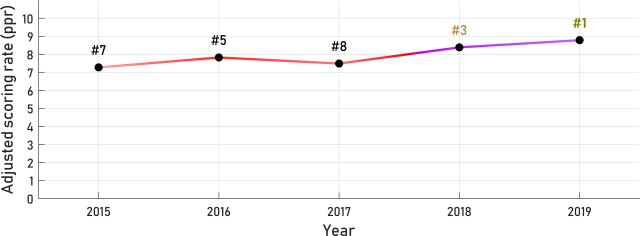


2019 was Max Verstappen’s finest season performance to date and his first time rated #1 by the f1metrics model. In only five races was he beaten by a teammate. In three of those, he was affected by extrinsic factors, including grid penalties (Italy) and accidents caused by other drivers (Vettel in Britain, Leclerc in Japan). Belgium and Mexico were the only races where Verstappen’s unfavorable result could be pinned directly on the driver. Verstappen ultimately outscored both Ferrari drivers in a car that the model considered clearly inferior to the Ferrari.
It is easy to forget, given Verstappen’s young age, that he was already in his fifth F1 season in 2019, equivalent in experience to Ayrton Senna in 1988 (his first title) or Lewis Hamilton in 2011 (already a champion). While Verstappen still has some potential for age-related improvement, he is expected to already be near peak performance based on experience. As I showed in the f1metrics top 100, Verstappen is on a unique trajectory with respect to the age-experience curve.
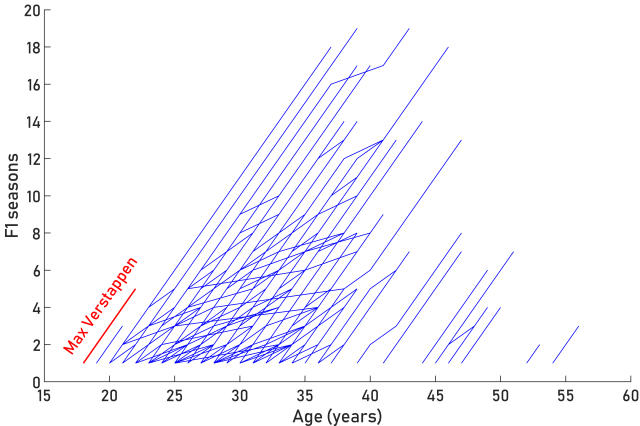
Max Verstappen’s unique position on the age-experience curve compared to all other drivers in the f1metrics database.
It is interesting to ponder how other drivers might have historically performed had they followed the same precocious beginnings as Max Verstappen. Taking Michael Schumacher as an example, he started racing in F1 in 1991 at the age of 22. Had he debuted at 17, after following the same accelerated path as Max Verstappen, he would have been an F1 rookie in 1986. In such a scenario, the f1metrics model projects that Schumacher would likely have been the best performing driver from 1989 into the mid-1990s. In the right car, he could conceivably have been a multiple champion prior to 1994.

With respect to Verstappen’s ability to deliver results, there is no longer any question. The burning question now is simply when he can find himself in a car capable of challenging for titles. Of the 33 drivers to win a drivers’ title, only 9 have taken more than six seasons to win the title. The Mercedes-Ferrari hegemony has effectively shut Red Bull out of championship contention since the beginning of the hybrid era. With Honda power, Red Bull are showing their first serious signs of in-roads into their competitors’ long-term power unit advantage. The 2020 season has again produced a dominant Mercedes car, but the technical overhaul of 2021 provides a largely blank slate where Red Bull could innovate. Hopefully, this can open the way to a fair fight between the two clearly strongest drivers of the current moment: Verstappen and Hamilton. That is a fight for the era that fans deserve to see, and one that would be expected to underline the sublime qualities of both drivers.
Thank you very much for posting this in the current environment, much appreciated.
Verstappen vs Hamilton is obviously the main talking point, as you’ve previously stated, The Red Bull/Toro Rosso dynamics are a bit weird, and have the capacity to throw up weird results, so although Verstappen is clearly an exceptional talent, I can’t help but feel that when drivers step out of the Red Bull stable they tend to underperform expections cf the model. Hamilton will also soon start to surely be past his age related peak soon as well, so our chances of a “fair fight” between the two are slim.
Vettel ahead of Leclerc is also another anomaly, I can’t think of much analysis that would crown Seb the winner last season. Leclerc does seem accident prone though, he’ll have to stamp that out if he ever gets into a serious title fight.
“Vettel ahead of Leclerc is also another anomaly, I can’t think of much analysis that would crown Seb the winner last season.”
How so? Vettel is bound to finish ahead because of Leclerc’s retirements, but if we disregard finishing positions and luck, it seems Vettel still had the upper hand in 11 races and Leclerc in 10, 7 of which were from France to Italy.
All of Leclerc’s retirements were accidents/collisions and only one of Vettel’s was. And in 2/3 races where Vettel retired due to mechanical issues his race was better than Leclerc’s.
I think this is a very interesting case. I can see why Vettel’s scoring rate was higher, as he had two mechanical retirements, whereas Leclerc had two retirements that were self-induced, but still I believe Leclerc had a better season. In fact, while I believe Leclerc is a very good driver, I felt Vettel had a pretty poor season by his standards. Especially during mid-season he was well of the pace and he was easily pushed into mistakes by Hamilton. Surprisingly, despite this, he was still pretty close to Leclerc in the championship, as Leclerc lost a lot of points early in the season through team-orders and weird strategy calls.
Australia – Vettel’s undercut on Hamilton backfired and he was passed by Verstappen later in the race. Leclerc had a better strategy, but couldn’t pass him. For some reason neither driver pitted again to score the bonus point for the fastest lap. No changes.
Bahrain – Leclerc was much faster than Vettel, who spun and damaged his nose, but still finished fifth. Leclerc dropped to third in the closing stages due to an engine problem. (Leclerc -10)
China – Vettel was faster than Leclerc, except for the first stint, when Leclerc was ordered to let him past. Leclerc was then undercut by Verstappen and never regained that place. (Leclerc -2)
Azerbaijan – Contrary to popular opinion Leclerc wasn’t fast in the race. He only looked fast because he’d started the race on the far superior medium tire. Both Ferraris more or less finished where they were supposed to.
Spain – Vettel messed up his braking for turn one at the start, costing him a chance to win the race. On flat-spotted tires he even had to let Leclerc past. Leclerc’s 1-stop strategy didn’t work out and he had to let Vettel past later on. A late-race safety car forced him to stop again. Had he just copied Vettel’s strategy, he would have finished ahead of Vettel. (Leclerc -2, Vettel +2)
Monaco – Leclerc was eliminated in Q1 as he was slow and Ferrari elected to save a set of tires. From the back of the grid Leclerc drove way too aggressively and quickly eliminated himself, but he likely wouldn’t have scored many points anyway. Vettel was somewhat lucky to finish 2nd. Hard to tell how much the Q1 elimination cost him, but even a sub-par performance would have given Leclerc a fourth place it seems, so likely some 12 points were lost.
Canada – Vettel was quicker than Leclerc, but an unforced error cost him the race.
France – No changes.
Austria – Ferrari really messed up this one I think. Vettel was ahead of Verstappen and running very fast, when he was converted to a weird 2-stop strategy. Starting on the red tires was probably a mistake anyway, but Ferrari had the pace to score a 1-2 instead of a 2-4. Vettel was quick enough to pass the overheating Mercedes and by pitting later he would at least have made Verstappen’s life more difficult. So, this time, both drivers lost out.
Britain – Vettel got his strategy right, whereas Leclerc lost out badly. In the end it didn’t matter, as Leclerc finished 3rd, while Vettel ran into the back of Verstappen and only finished 16th.
Germany – Leclerc crashed when everything was going his way. Vettel’s pace wasn’t impressive at all, but at least he kept his head cool and finished second.
Hungary – Vettel’s better tire management earned him a third place at the expense of Leclerc.
Belgium – Leclerc managed to win by the skin of his teeth, while Vettel was used as a road block to stop the Mercedes. He finished fourth, which was were he deserved to finish.
Italy – Leclerc again won by the skin of his teeth, while Vettel spun and nearly caused a nasty accident when he tried to rejoin. A race to forget for him.
Singapore – Leclerc was leading the race from pole position and he was driving very slowly to nurse the tires. When he finally tried to up his pace, his tires almost immediately faded. Vettel then covered Verstappen’s undercut and managed to undercut both Hamilton and Leclerc. A bit of a lucky victory, although he managed to overtake the midfield runners more easily than Leclerc did.
Russia – A weird team tactic saw Vettel jump Leclerc at the start, after which he refused to give back the position. Ferrari then decided to allow Leclerc to undercut Vettel, which backfired immediately as Vettel’s dying engine caused a caution. This allowed both Mercedes to jump Leclerc and score an unlikely 1-2. Again, both drivers lost out.
Japan – Vettel was better and Leclerc clumsily hit Verstappen in turn one, after which he only finished 6th.
Mexico – Another poor strategy call cost Ferrari a pretty much guaranteed win. For whatever reason Ferrari covered an Albon undercut with Leclerc, who was leading the race. As Albon had lost five seconds battling Sainz in his out-lap, this absolutely made no sense. Leclerc then had to stop again, which was the losing strategy, so he only finished 4th. Vettel was then undercut by Hamilton and finished 2nd. Without the strategy blunder, Ferrari would have been able to cover the Hamilton undercut and finish 1-3 at least.
United States – The first race in which Ferrari wasn’t very competitive. Leclerc finished a distant 4th, whereas Vettel had a terrible opening lap and retired early in the race with a broken suspension.
Brazil – Neither driver finished as they eliminated each other. Vettel had been quicker for most of the race, but Leclerc had a slight tire advantage at the end of the race, so he made a move. The collision was 100% Vettel’s fault, though.
Abu Dhabi – Vettel had a pretty poor weekend and only just finished 5th, whereas Leclerc was on a weird 2-stop strategy and lost 2nd place to Verstappen. (Leclerc -3)
All in all, Leclerc should have scored at least 17 points more. Including the Monaco qualifying blunder and the poor strategies in Austria, Singapore, Russia and Mexico, he could have scored 49 extra points for a total of 330 points. Vettel only lost a lot of points in Russia (he probably wouldn’t have scored many points in the US) and some in Austria, but he benefited in Singapore and Spain, so he would only have scored 17 more points for a total of 257 points. This indicates that Leclerc was the better driver in 2019.
If you want to claim Vettel was better than Leclerc last year then be my guest! I think the model throws up surprising results for two main reasons: (i) It (rightly) punctures pre existing narratives that don’t stand up to more rigorous analysis, and (ii) it just has blind spots that more rounded, human analysis can see through. I think this is clearly a case of the latter.
The only problem is that human analysis of each pairing in the history of the sport is a tad impractical 🙂 The blind spots of this model also revealed our own blind spot of always favoring the faster driver. That’s why it’s normal to think Leclerc dominated and not suprising for Vettel to come out on top by a hair in terms of ppr.
But you don’t need to do a human analysis of every pair of F1 drivers in history to compare Vettel and Leclerc last year. For what it’s worth, I certainly don’t think Leclerc “dominated”, but I think he was cleanly the better of the two drivers, and the fact that it was his 2nd year in F1 and coming into Seb’s team underlines that. I think that assertion is pretty clearly backed up by their respective performances this year as well.
Welcome back. I’m glad to see that you’re OK and that this great series might continue.
Caught a few typos in the article: Ferrai, pactually, maybe one more.
Couple of questions:
Do you see any slowing in the rate of age related performance decline with modern drivers? Drivers in better shape? Living healthier? Cars easier to drive?
And how bad must have Indycar been for Fittipaldi or Andretti to remain competitive up to age 50?
Is the Williams car performance within the model only based on Kubica’s estimated level?
IndyCar wasn’t that bad. For sure driver level has always been subpar to F1’s but it was another car altogether. Less focused on physical demands and reflexes, since it was slower, but needed more driver control, tyre management and fuel management and hence experience from the driver. That gave older drivers an edge and kept them competitive for longer, plus the fact that the gaps between teams are way, way smaller than F1.
Dimitris, wouldn’t the small gaps make it worse? If the car is sufficiently dominant, I suppose it might not matter how old you are. But if the competition is very close, that must mean it is not very strong for a 50 yo to compete?
In a clear pecking order like F1’s a driver is pretty much expected to finish in a given position +-2 and that means next to no space for a “miracle”. In IndyCar you can be a hero on one weekend, a zero on the other, but people will remember the good ones. Perfect example in recent history is Takuma Sato. He’s old, hasn’t done much in IndyCar, bar a couple of wins and the 2 Indys. People remember the Indy 500s but tend to forget the many mediocre races he has had or the luck involved.
Amazing work once more. Your blogs are a must read for any F1 fan. Not only they are great to read but also help immensely to put in context what we see in the circuits each season.
I have a question regarding Hamilton. Given that most times the model places him second best performer i would like to see an assessment on how he places amongst other multi-champions. He’s perceived as an “exceptionally mature” driver nowadays but that’s easy given his cars advantage, the intra-team level of competition and the fact that modern cars rarely retire or driver mistakes are rarely punished in parking-lot circuits. His all time placement seems to me somewhat inconsistent with what the year end model shows. He’s been the best driver only twice in his career and he’s driven the most dominant cars in history for most of it.
As for the Verstappen-Hamilton fight, given that F1 once again shot themselves in the foot by prolonging the stagnant status quo for 2021 too and that Mercedes might jump ship sooner rather than later, i’m afraid we’re running out of time to see it happen…
Hurray! Thank you for this, wonderful.
Great to have you back! I’ve been waiting for this for a while! Generally the ratings seem perfectly fair to me – I remember thinking after 2019 that for me Verstappen (in particular) and Sainz really were the stand-out performers – and reinforce my view that Pérez is very underrated and that RBR should take him for 2021. I think your model is really coming along nicely now with more driver connections and with the added age and experience effects. I remember thinking that some of the rankings before those effects were added were a bit strange, but as I said, now they seem a bit more logical. Great work!
One question: what were the models predictions going into the 2020 season for the intra-team battles?
Thank you for yet another awesome piece! It’s great to have you back. Do you have a paper or any other documentation on the inner workings of the model I could read, would be very interested in the math behind it.
It will be very interesting to see where Leclerc ends up in the overall top 100 rating after 2020, seeing as how he has dominated 8th placed Vettel this year.
As always – a great review! Lots of things changed though. For verstappen he probably won’t have any hopes for a competitive car for years to come, since the technical overhaul is postponed to 2022 and Honda leaving the F1. Sad!
I really love this blog and I think it is a precious source of info and insight to any F1 fan. Indeed, I tend to suggest it to any F1 fan I meet.
I would be interested in a new ranking of the most dominant F1 cars ever, since if I’m not mistaken the old one was based on the old model. If so, I would be extremely curious to see how the ranking would be modified with the new model, seeing how the drivers ranking was deeply changed.
Thank you for sharing all your work.
I’m just here for the obligatory “will we get a 2020 end of season report?” 🙂
Great to see these back, thanks!!
Looking forward to hopefully seeing the ratings hierarchy after 2020 with a few more drivers linked.
Any chance of a forecast for 2021’s new driver pairings? i.e. how close do we expect Sainz to push Leclerc, Perez & Max etc?
I can’t believe it’s taken me this long to see that you had put a new post up, thank you for carrying on!
Big fan of this blog! I’m sure it takes some major effort, but when possible can we have a top 100 driver update and some data/insight about 2021? Given the season I think your input would be awesome!
Huge fan as well. Would love to see new content on here, if you have the time.